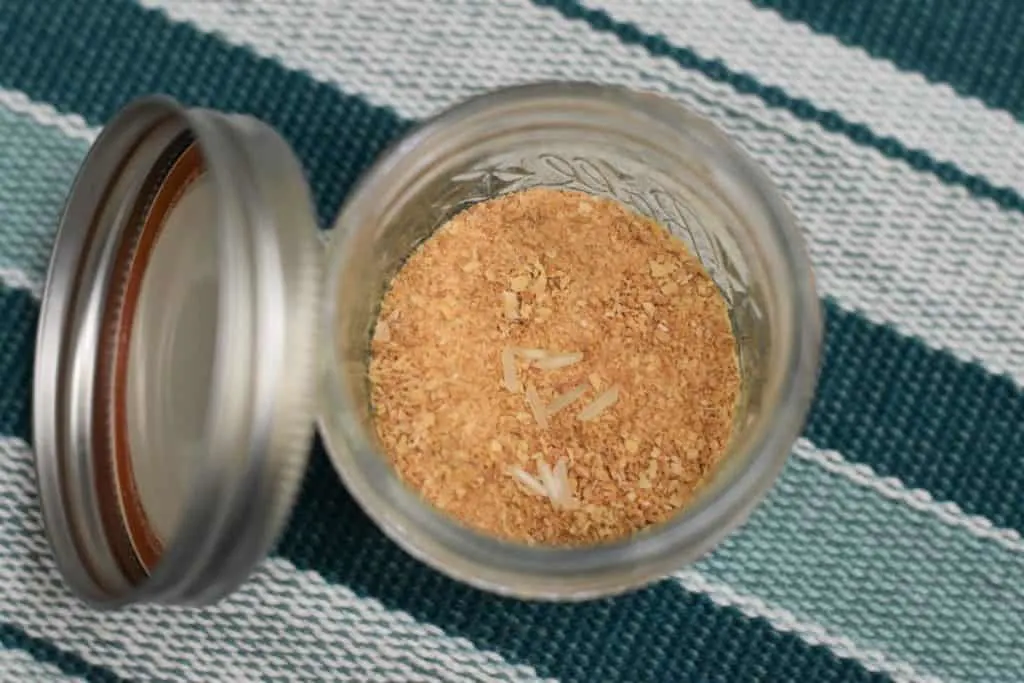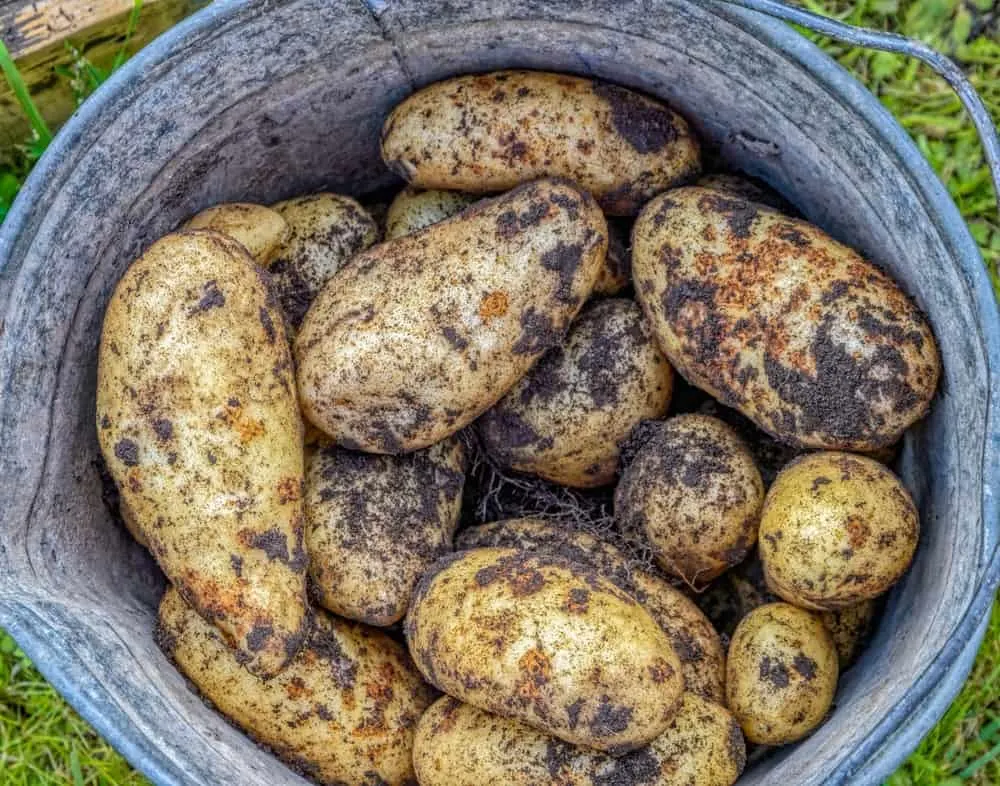
Growing your own is not just about sowing, growing and harvesting. It is also about making sure that you make the most of the crops that you grow. This means finding ways to store and preserve the bounty of the busiest times to feed you through the rest of the year.
Onions are a great value crop to grow. Grow the right varieties in the right places and in the right ways, and you can eat them throughout most of the year.
Onions planted in the fall and overwintered may now be ready for harvest. Spring sown sets will usually not be ready until very late in the summer, or early in the fall.
I have recently harvested my fall sown onions, so now seems a good time to share with you some strategies to help you harvest, cure and store onions so they last longer.
Get it right and your onions could last you right through until spring – and perhaps even beyond.
How To Tell When To Harvest Onions
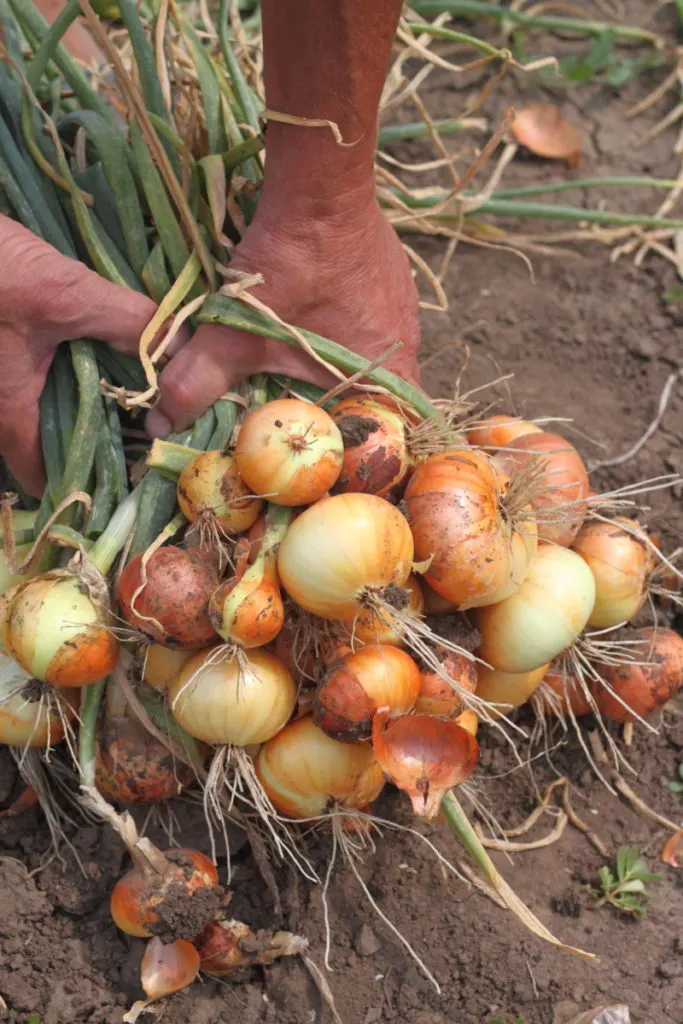
The first thing to understand about onions and storage is that onions that are fully ripe and fully mature will store best, and keep for longest.
Harvest too early, and you could find that immature bulbs are not only smaller, but also harder to store. But leave it too long, and you might discover that your onions have fallen prey to a range of pests and problems.
Preparation for harvest begins as soon as the bulbs have swollen around mid summer. (In June, you may have added potash to help bulbs ripen). At this time, once bulbs have swollen, it is time to stop watering and feeding.
For best results, onions should not be fertilized (especially with nitrogen) during the final six weeks or so of their growth.
After a while, the foliage will naturally begin to yellow, and may flop over.
Some traditional gardeners may recommend that you bend over the foliage or lift the bulbs to break the roots. But these techniques are no longer recommended.
Instead, simply wait for the stems to yellow and flop on their own. Once at least a third of your crop is showing signs of natural foliage die-back, you can harvest your crop.
Harvesting Onions Without Damaging Them
Another important thing to remember when harvesting onions for storage is that damaged onions will not last as long. It is important to take care during the harvest to avoid damaging the bulbs.
To keep onion bulbs as intact and unblemished as possible, it is best to use a garden fork or another gardening tool to gently ease the onions from the soil, rather than trying to yank them up by hand.
Lay the harvested onions gently to one side – don’t toss them around. Check each one over as you harvest it, gently dusting off the worst of the dirt.
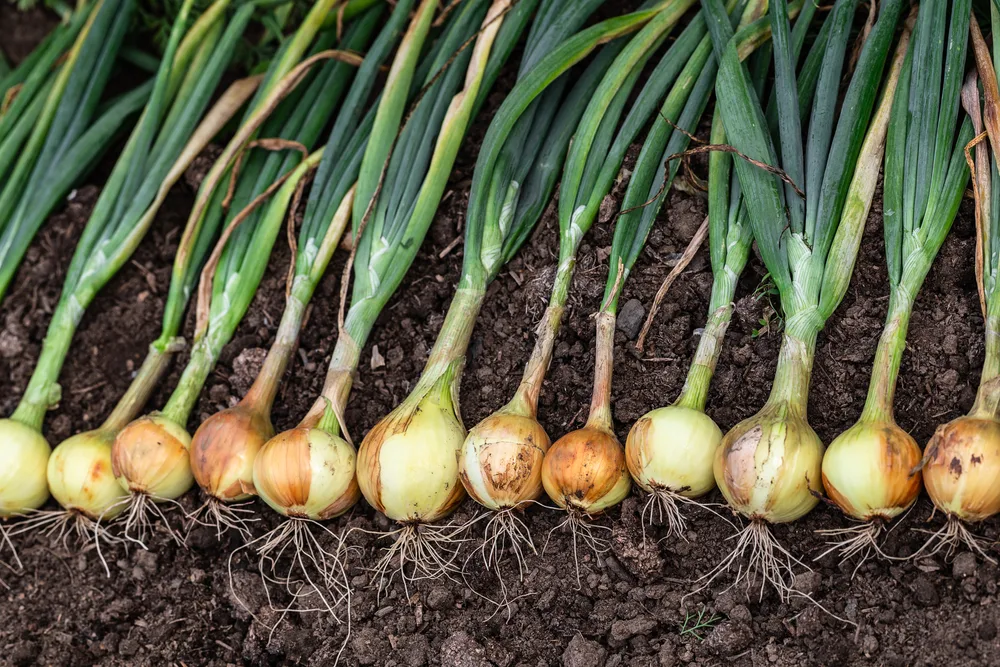
Put any that are showing signs of damage, or any that are smaller or malformed to one side. You can put these in a pile to be used up more quickly.
Curing Onions
The next stage of the process, to make sure onions last as long as possible, is to cure your onions.
Curing is simply the name we give to the process of drying the outer layers of the onions to give them protection in storage.
The curing process is all about removing all surface water or moisture from the outer surface of the onion, and drying the three or four outer layers of skin. It also involves allowing the stem to dry out, which will seal that access point off and protect the onions’s insides.
Ideally, onions should be cured at between 77 and 86 degrees for best results. They should be placed somewhere warm and dry with reasonably good ventilation.
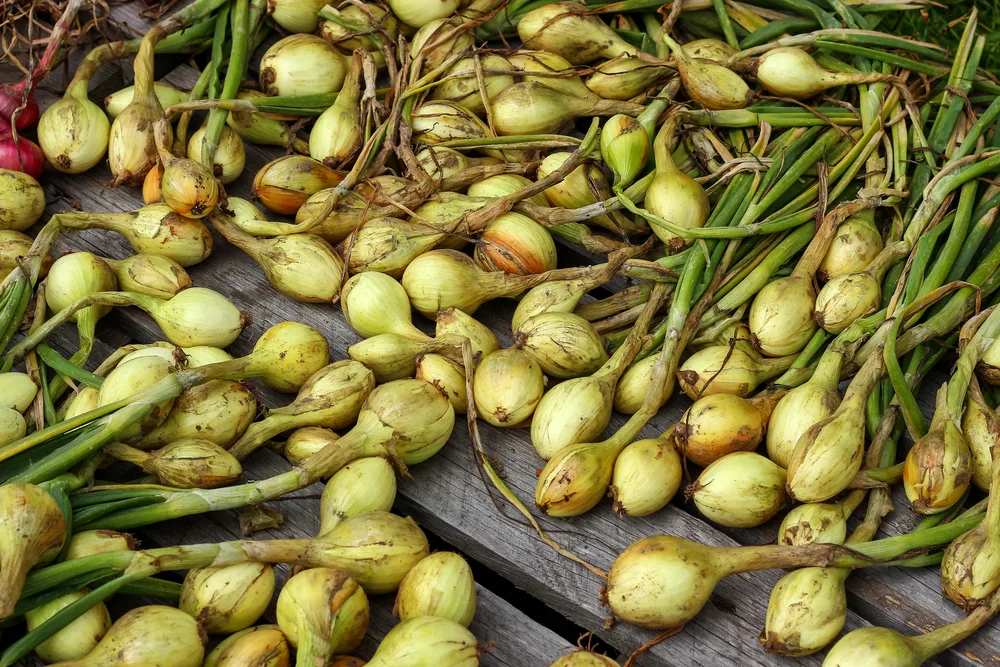
In cooler, more humid climates like mine, that means drying them inside my polytunnel. I have a hanging shelf in my polytunnel that I use for curing onions, and other crops like garlic, and squash.
Though you may also be able to cure them on a sunny porch or veranda, or even outside if you experience hot enough temperatures and dry enough weather where you live. If you are curing onions outside, it is best to keep them up and out of the dew. And to cover them if rainfall is expected.
Spread out your onions in a single layer, and leave them until the necks have tightened up, stems are free from moisture, and the outer skins are all papery and have tightened around the bulbs before you even consider moving them for long term storage.
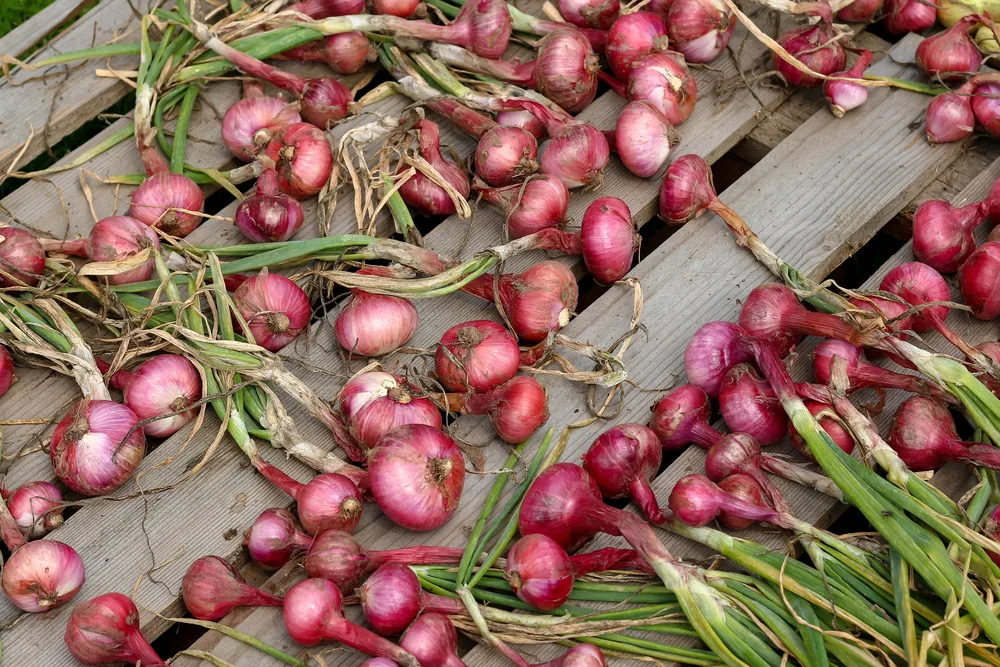
Identifying Onions That Will Store For Longer
One very important thing to mention before we go any further is that some onion varieties will last much longer than others. It is vital to understand the storage properties of the variety or varieties you are growing.
Typical bulb onions will belong to one of two onion types. They will either be mild onions (which are usually poor for storage and which must be used up within a few weeks), or pungent onions, which can typically be stored, in optimal condition and in an ideal environment, for ten months, or even up to a year.
Common mild onion varieties include Bermuda, Spanish, Vidalia and Walla Walla sweet.
Some common pungent onion varieties are Candy, Copra, Ebenezer and Red Weathersfield.
If you are not sure which variety or varieties you are growing, or are not sure whether your onions are pungent or not, cut into them. Onions that make you cry when you cut into them will last longer. The sulfurous compounds that make our eyes sting also inhibit rot.
So put your most pungent onions into a pile for longer term storage. And use milder onions up more quickly, or preserve them in other ways.
Where to Store Onions
The best place to store onions is in a cold store/ pantry or old fashioned root cellar. But of course, not everyone has these spaces.
A regular cellar, garage or shed can also work well. To make sure that your onions last as long as possible in storage, aim for consistent temperatures between 35 and 40 degrees F.. For best results, relative humidity should be kept between 55% and 65%.
The goal is to create a cool, dark environment, with a little ventilation but not too much.
In such an environment, rot is less likely to set in, and the onions will not lose too much weight through respiration. A little ventilation is needed so that there is not an increase in CO2 levels, and to dissipate heat generated by the onions as they continue slowly to respire.
Onion Storage Solutions
In addition to thinking about the general environment in which your onions should be stored, it is also a good idea to think about storage solutions.
There are a number of ways to effectively store your onions that can provide the right conditions and allow you to keep them for longer.
Here are some examples of the options you could consider for onion storage:
In Braids Hanging from the Ceiling/ Hooks
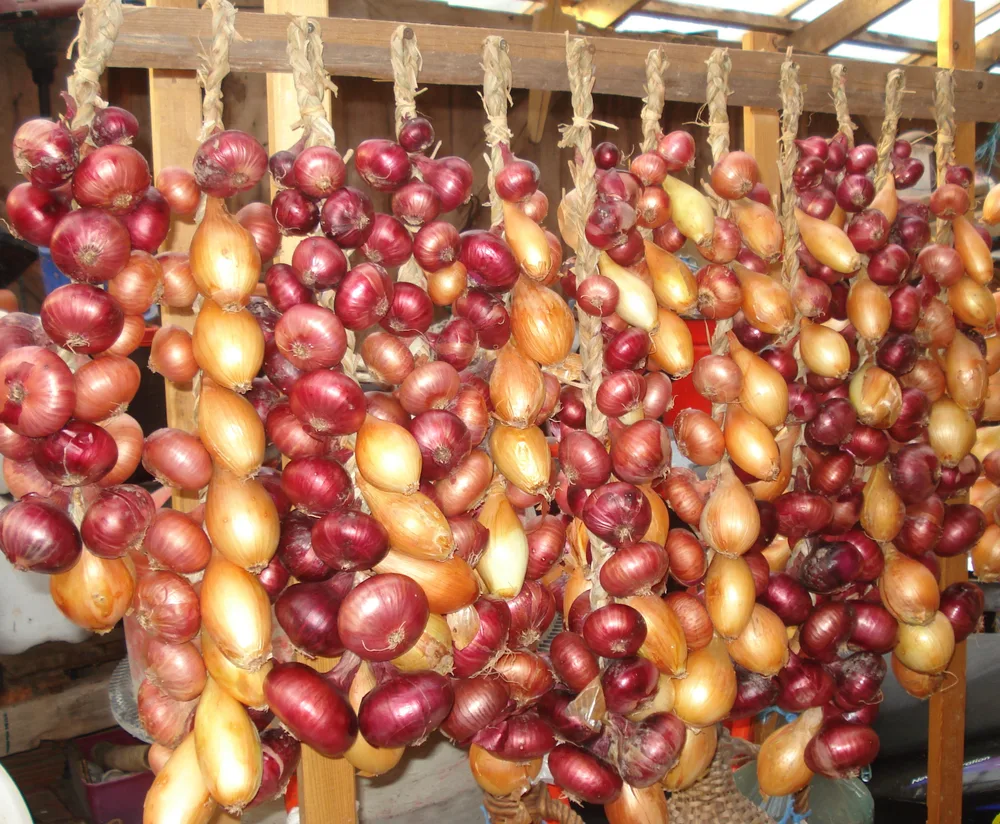
Braiding onions is a traditional way to prepare them for storage. In addition to looking decorative, braiding them can also help keep them fresh.
The braids can be hung from a ceiling or from hooks, and this means that they are sure to get a light amount of ventilation.
Another advantage of creating braids is that you can also easily see all your onions. And to remove any that might be beginning to spoil as soon as you see signs of a problem.
Braiding onions is just the same as braiding hair. So if you know how to make a braid with hair, you will easily be able to braid the onions.
Just remember, if you plan to braid your onions, to leave a ‘tail’ of dried stem on each bulb so you have enough length to work with.
How To Braid Onions
Begin with three onions, lay them out together, then braid their stems – right to middle, left to middle, right to middle etc.. Then take the stem of a fourth onion and add it to the stem at the centre. Again, braid by taking the right to the middle, then the left to the middle. Continue to add onions to your braid in this way, making sure that you take up the new stems you add each time.
If this seems a little too difficult, or the stems are too short or breaking easily, there is another way to make strings of onions that is even easier. For this second option:
- Take a length of twine and make a loop by tying the ends together. (Make this long enough to accommodate the number of onions you want to have on each string.)
- Take an onion and wind the stem in a figure of eight pattern around the base of the string, between and around the two upright strands.
- Add your next onion, and make another figure of eight pattern, passing the stem between the two upright strings from front to back
- And then another onion, this time going first front to back before making the figure of eight pattern.
- Continue until you have added enough onions to your string.
The twine will help keep your strings of onions in tact. And you won’t need as much stem to keep each onion firmly secured.
Here’s a video tutorial showing how to braid your own homegrown onions:
In Mesh Bags/ Hose
Of course, braiding your onions is traditional. But it is most definitely not your only option. You can also simply hang your onions in mesh bags.
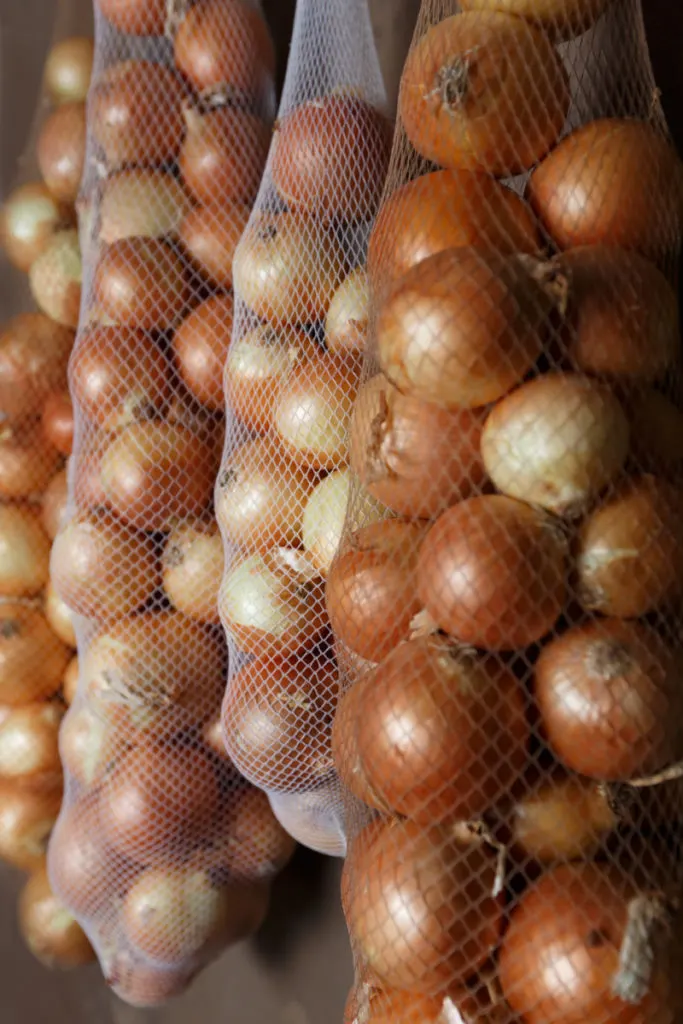
Another interesting variation of this idea is hang your onions in old hose.
Take a leg and drop an onion into the base. Tie a knot, then add another one. Then continue to do this to safely store your onions. Each time you need an onion, you can simply cut each knotted section open to retrieve one. Sheer hose will allow you to see what’s what, and keep an eye on the onions you store.
In Cardboard Boxes With Holes
Another simple DIY option is simply to store your onions in flat cardboard boxes with holes cut in them to allow some air flow. Again, this is an option that will allow you to keep an eye on them while they are in storage.
It is best, if storing your onions in boxes, to make sure that they are in a single layer, and not touching one another.
In Wicker Storage Baskets
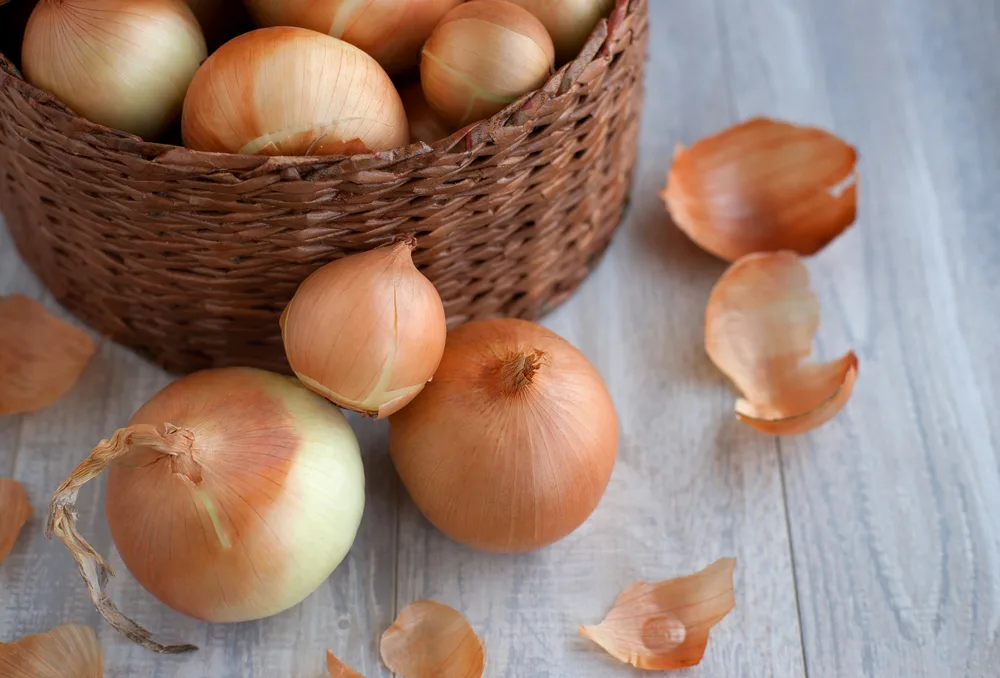
Some growers simply opt to keep their onions in wicker storage baskets. If you do not have a huge number of onions to store, it can be perfectly practical to store them in this way.
Wicker baskets allow for some ventilation without leaving your onions entirely open to the surroundings.
On Orchard Racks
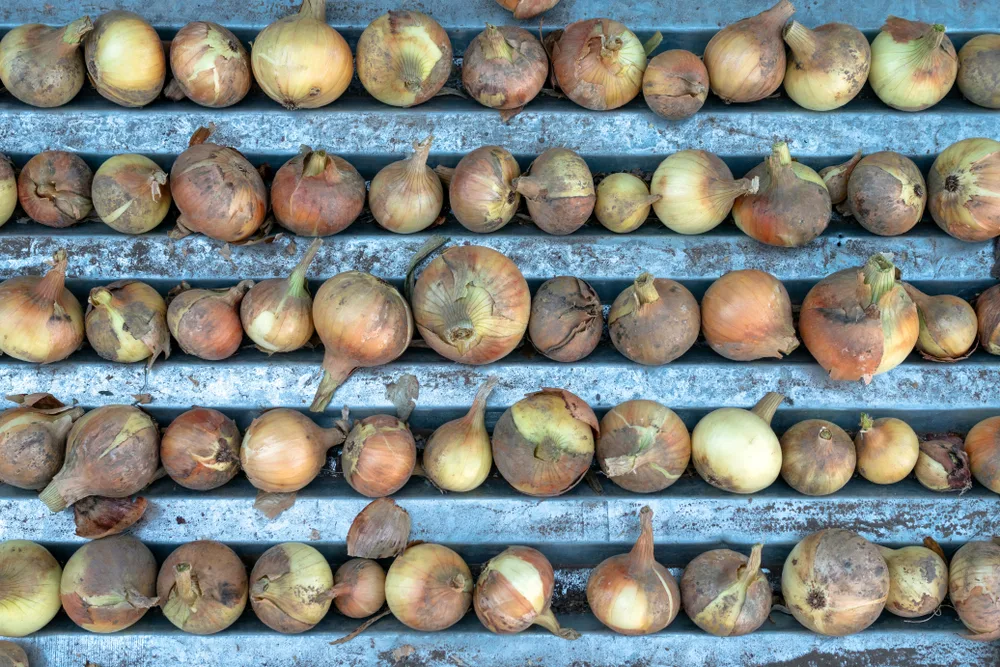
Finally, you can also consider storing your onions on dedicated racks.
Orchard racks are designed to provide a series of well-ventilated, slatted shelves for the storage of a range of fruits and vegetables. You can either buy one, or, better yet, make your own from reclaimed timber.
One thing to mention, however, is that it is not a good idea to store onions in too close proximity to other stored crops. Storing onions near other crops, like potatoes and apples for example, can affect their taste.
Freezing Onions
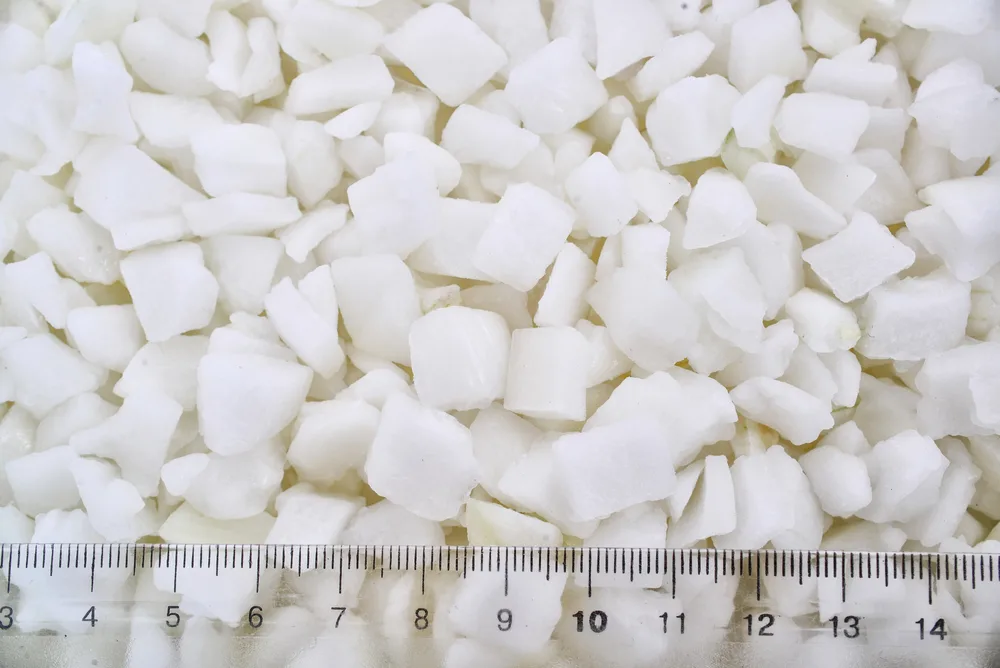
If you don’t have a lot of space for storage, or will find it challenging to provide appropriate conditions for cool storage where you live, you might be wondering whether you can freeze your onions. The good news is that the answer is yes.
Freezing can be a good way to deal with mild onions that will not last as long in cool storage.
The best way to freeze onions is simply to chop them and seal the un-blanched, chopped pieces in jars or containers.
To stop the frozen pieces from fusing together, and for easier retrieval, freeze the chopped pieces first spread out on a tray before putting them into sealed containers.
You can then simply tip out as much you need for a meal without defrosting the whole lot.
Of course, most people, if they have a freezer, will only have limited freezer space. And of course we should think about energy use when finding ways to store and preserve food.
We freeze food here because we have 100% renewable energy. (Though I do not usually find it necessary to freeze onions, I do freeze some green veg.) But where you do not yet have 100% renewables, it is more eco-friendly to find low-tech and traditional ways to preserve food.
Here’s Rural Sprout author, Tracey’s guide to freezing onions with five different techniques to try.
Dehydrating Onions
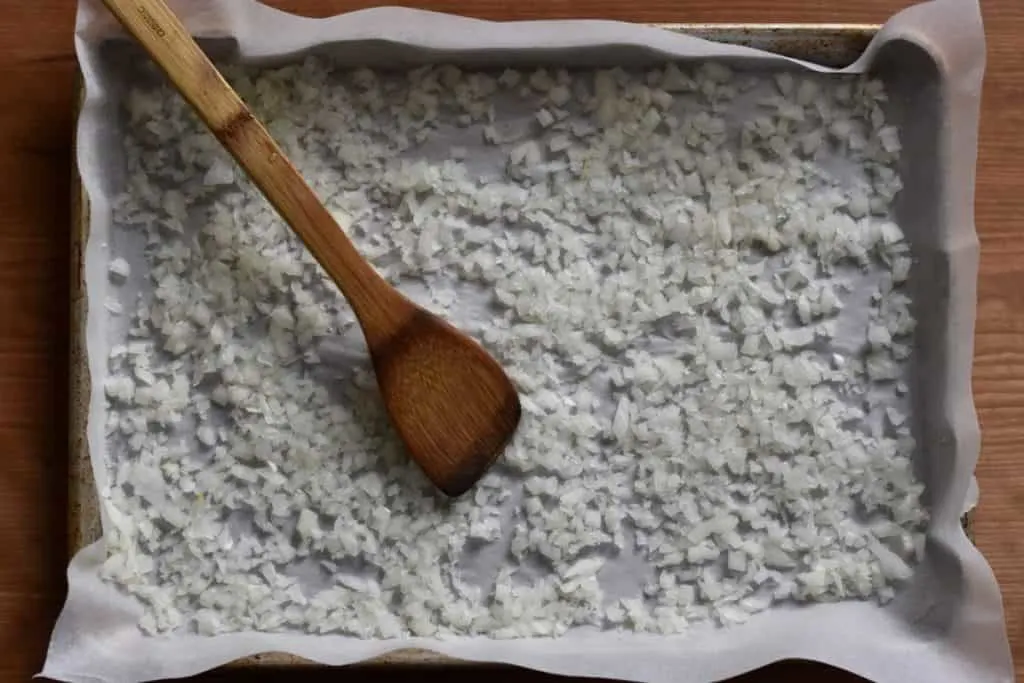
One traditional way to preserve onions is by dehydrating them. Onions can be dried in a solar dehydrator, electric dehydrator or in your oven or stove.
The fully dehydrated onions can also then be powdered to make onion powder.
This can be a helpful ingredient to have on hand for a range of soups, stews and other dishes. The process of making onion powder is very similar to that used to make garlic powder.
Other Ways To Preserve Your Onion Crop
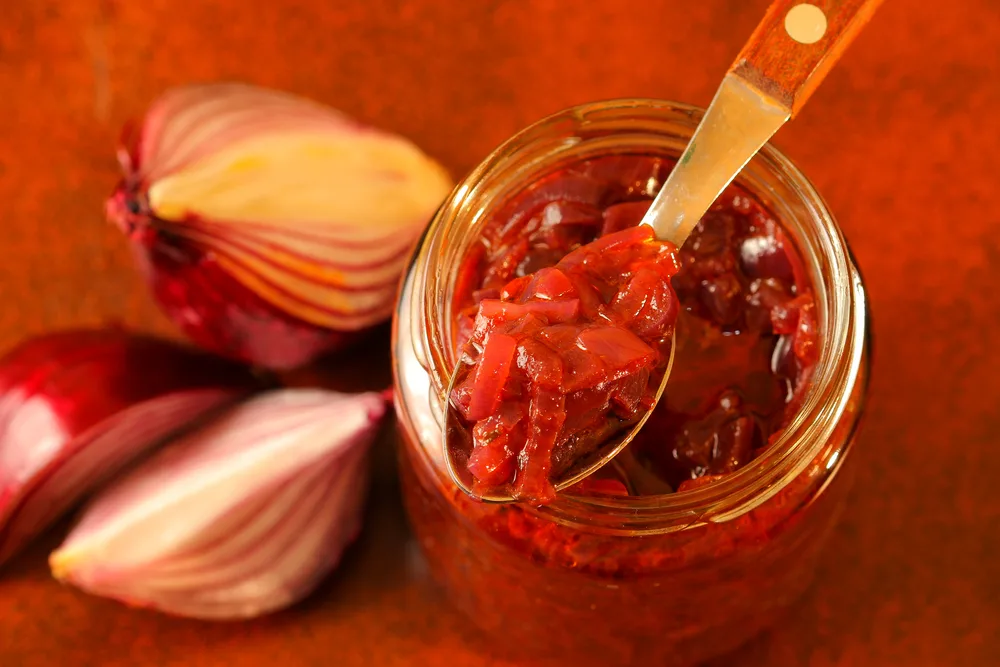
Onions that will not last well in traditional storage can also be preserved in a range of other ways. There are a number of recipes that you can use to make preserves and condiments that will last over the winter months. Most involve using either sugar or vinegar, or both, in the preservation.
For example, I often use onions to make recipes such as onion chutney. Sometimes, I will use onions and windfall apples, along with certain spices to make a chutney that is great with salads or sandwiches.
I also make a caramelized onion jam. Here’s a great recipe for that.
Pickled onions are another way to preserve onions for long term. I find that pickled onions are either loved or loathed.
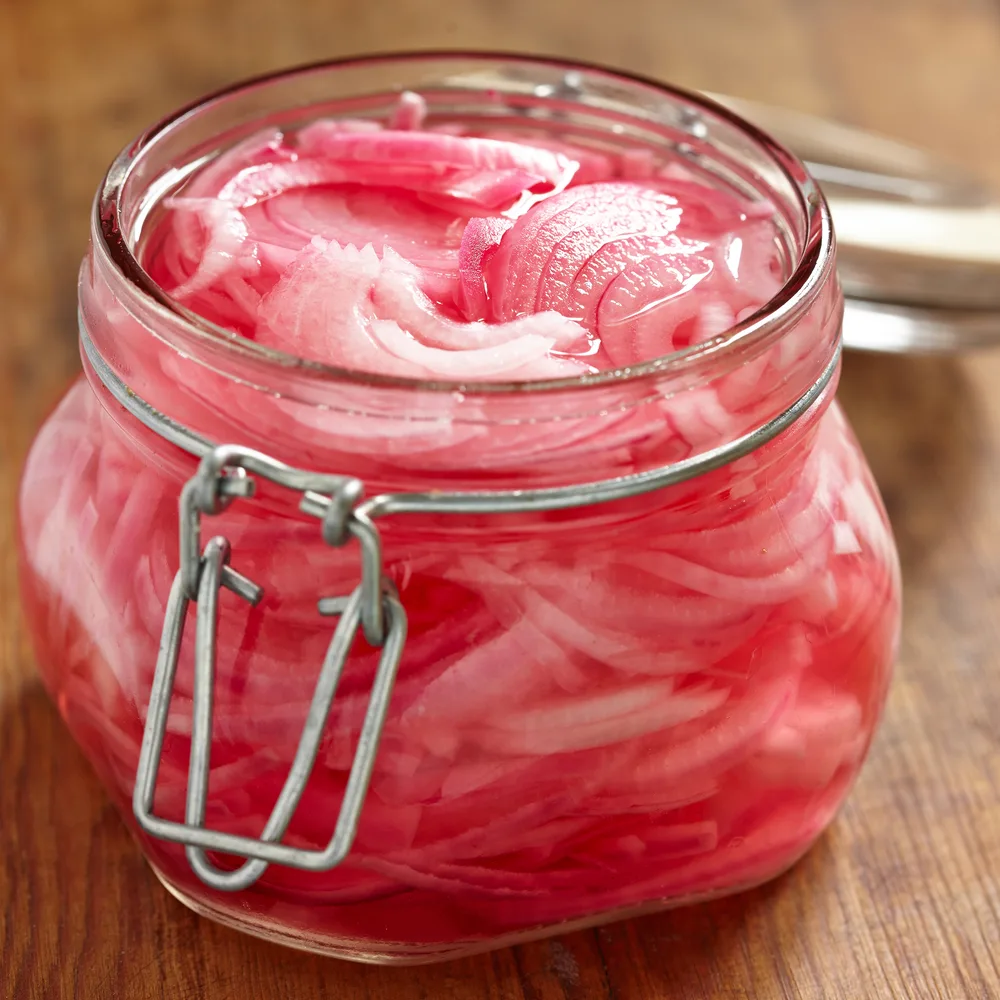
By separating your onions into separate groups that can be used in different ways, you can make sure you don’t waste a single one.
You’ll be able to make the most of all the onions that you grow, and have plenty of alliums to enjoy right through until next year.
Read Next:

Get the famous Rural Sprout newsletter delivered to your inbox.
Including Sunday musings from our editor, Tracey, as well as “What’s Up Wednesday” our roundup of what’s in season and new article updates and alerts.


